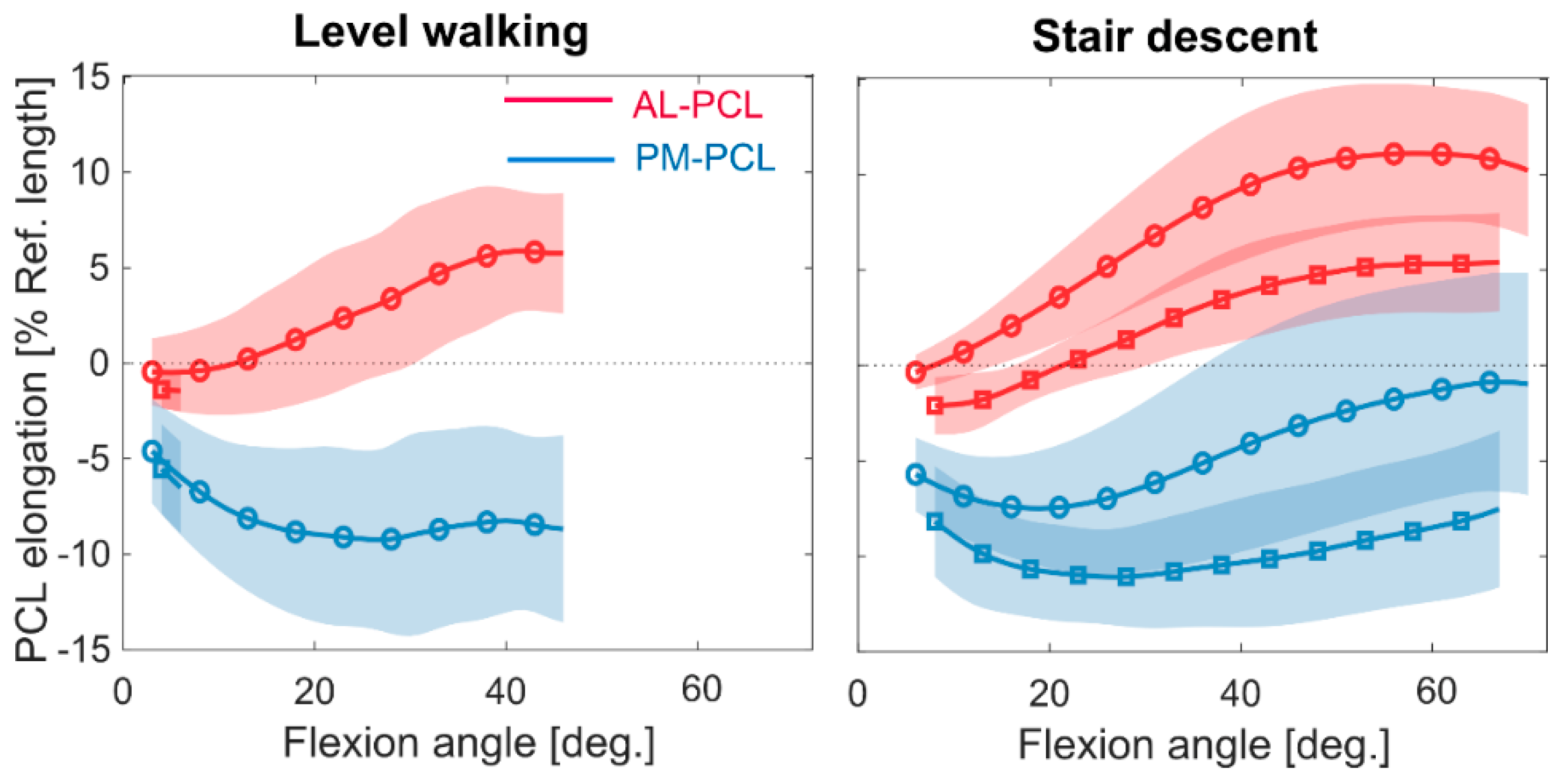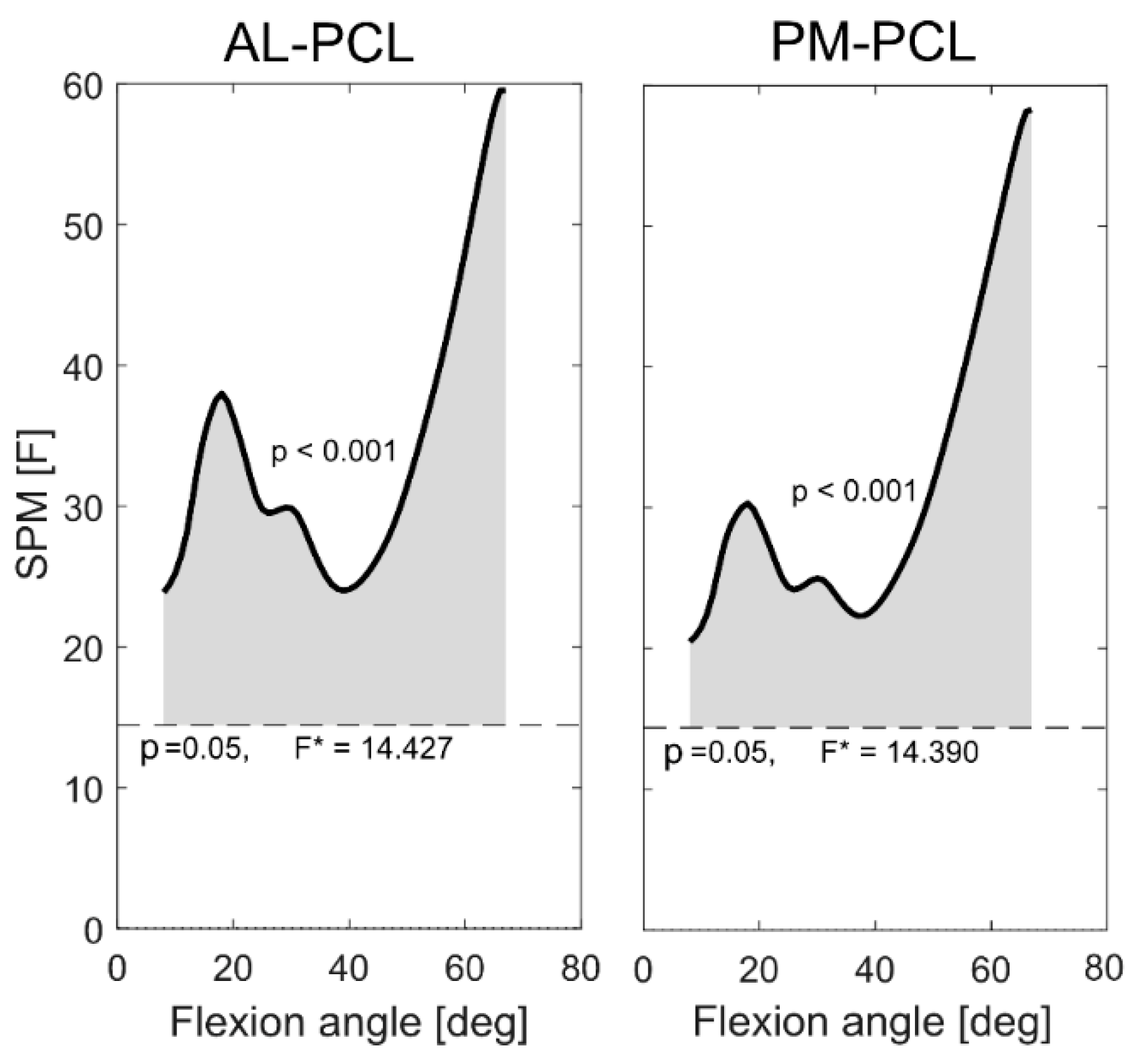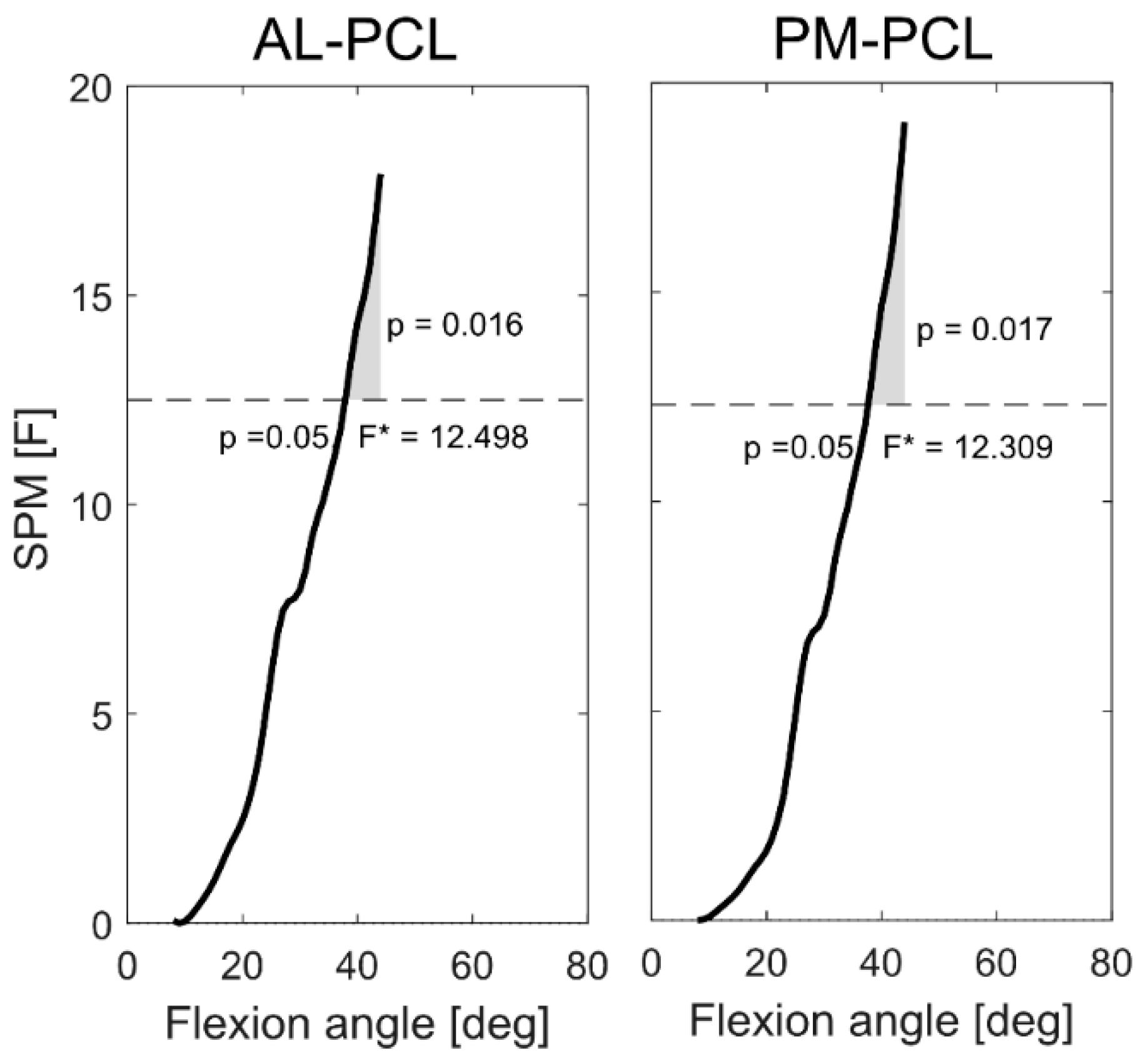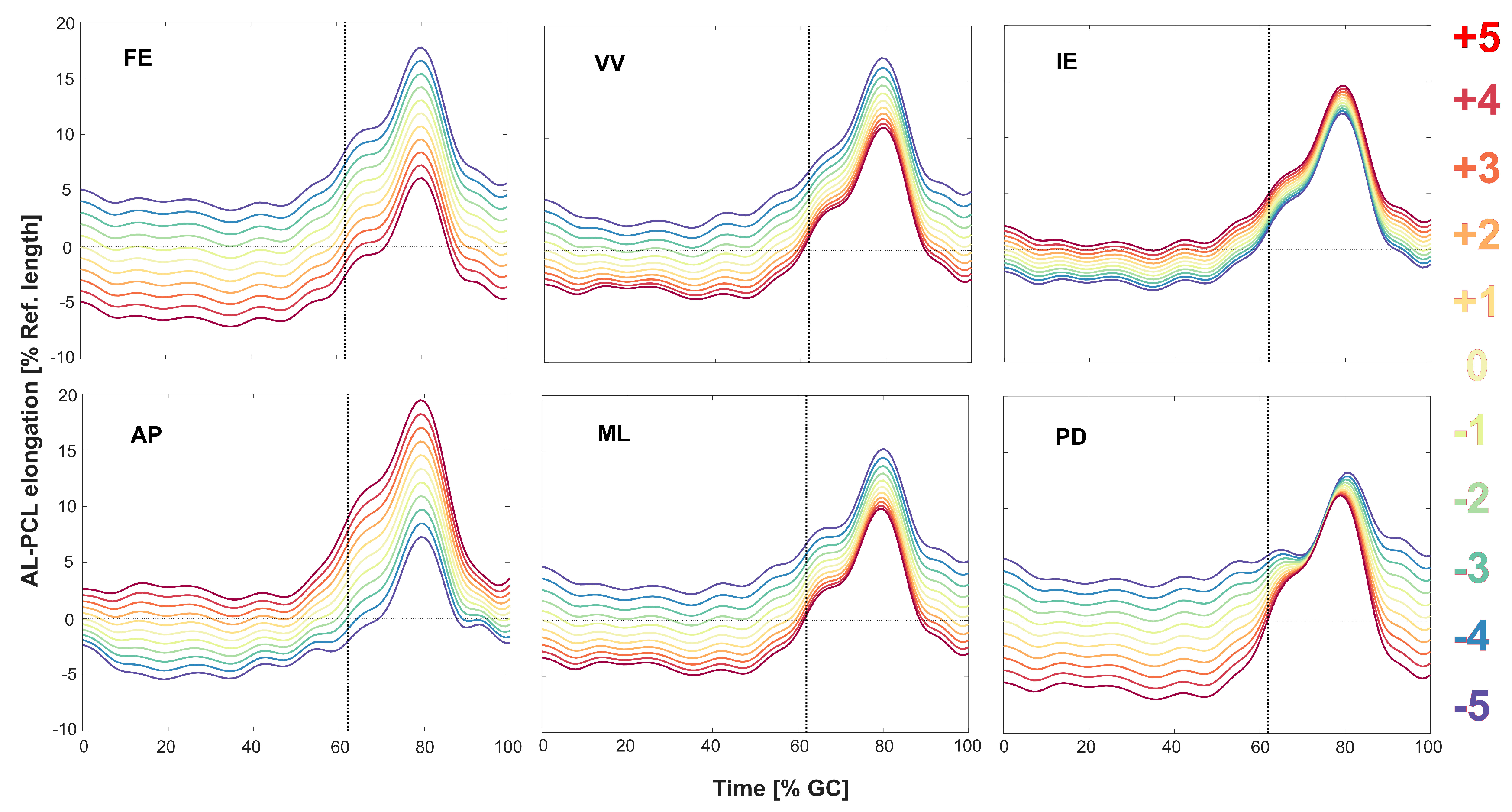Elongation Patterns of the Posterior Cruciate Ligament after Total Knee Arthroplasty
Abstract
1. Introduction
2. Methods
3. Results
4. Discussion
5. Conclusions
Supplementary Materials
Author Contributions
Acknowledgments
Conflicts of Interest
References
- Hirsch, H.S.; Lotke, P.A.; Morrison, L.D. The posterior cruciate ligament in total knee surgery. Save, sacrifice, or substitute? Clin. Orthop. Relat. Res. 1994, 1994, 64–68. [Google Scholar]
- Emodi, G.J.; Callaghan, J.J.; Pedersen, D.R.; Brown, T.D. Posterior Cruciate Ligament Function Following Total Knee Arthroplasty. Iowa Orthop. J. 1999, 19, 82–92. [Google Scholar] [PubMed]
- Andriacchi, T.P. Biomechanics and gait analysis in total knee replacement. Orthop. Rev. 1988, 17, 470–473. [Google Scholar]
- Mahoney, O.M.; Noble, P.C.; Rhoads, D.D.; Alexander, J.W.; Tullos, H.S. Posterior cruciate function following total knee arthroplasty. A biomechanical study. J. Arthroplast. 1994, 9, 569–578. [Google Scholar] [CrossRef]
- Verra, W.C.; Boom, L.G.H.V.D.; Jacobs, W.C.H.; Schoones, J.; Wymenga, A.B.; Nelissen, R.G.H.H. Similar outcome after retention or sacrifice of the posterior cruciate ligament in total knee arthroplasty. Acta Orthop. 2014, 86, 195–201. [Google Scholar] [CrossRef] [PubMed]
- Li, G.; Zayontz, S.; Most, E.; Otterberg, E.; Sabbag, K.; Rubash, H.E. Cruciate-retaining and cruciate-substituting total knee arthroplasty: An in vitro comparison of the kinematics under muscle loads. J. Arthroplast. 2001, 16, 150–156. [Google Scholar] [CrossRef] [PubMed]
- Seon, J.K.; Park, S.J.; Lee, K.B.; Yoon, T.R.; Kozanek, M.; Song, E.K. Range of Motion in Total Knee Arthroplasty: A Prospective Comparison of High-Flexion and Standard Cruciate-Retaining Designs. J. Bone Jt. Surg. Am. Vol. 2009, 91, 672–679. [Google Scholar] [CrossRef]
- Lützner, J.; Firmbach, F.-P.; Lützner, C.; Dexel, J.; Kirschner, S. Similar stability and range of motion between cruciate-retaining and cruciate-substituting ultracongruent insert total knee arthroplasty. Knee Surg. Sports Traumatol. Arthrosc. 2014, 23, 1638–1643. [Google Scholar] [CrossRef]
- Cho, K.-Y.; Kim, K.-I.; Song, S.-J.; Bae, D.-K. Does Cruciate-Retaining Total Knee Arthroplasty Show Better Quadriceps Recovery than Posterior-Stabilized Total Knee Arthroplasty? - Objective Measurement with a Dynamometer in 102 Knees. Clin. Orthop. Surg. 2016, 8, 379–385. [Google Scholar] [CrossRef]
- Wünschel, M.; Leasure, J.M.; Dalheimer, P.; Kraft, N.; Wülker, N.; Müller, O. Differences in knee joint kinematics and forces after posterior cruciate retaining and stabilized total knee arthroplasty. Knee 2013, 20, 416–421. [Google Scholar] [CrossRef]
- Lotke, P.A.; Corces, A.; Williams, J.L.; Hirsh, H.S. Strain characteristics of the posterior cruciate ligament after total knee arthroplasty. Am. J. Knee Surg. 1993, 6, 104–107. [Google Scholar]
- Incavo, S.J.; Johnson, C.C.; Beynnon, B.D.; Howe, J.G. Posterior cruciate ligament strain biomechanics in total knee arthroplasty. Clin. Orthop. Relat. Res. 1994, 309, 88–93. [Google Scholar]
- Banks, S.A.; Hodge, W.A. Implant Design Affects Knee Arthroplasty Kinematics during Stair-stepping. Clin. Orthop. Relat. Res. 2004, 426, 187–193. [Google Scholar] [CrossRef]
- Delport, H.P.; Banks, S.A.; De Schepper, J.; Bellemans, J. A kinematic comparison of fixed- and mobile-bearing knee replacements. J. Bone Jt. Surg. Br. Vol. 2006, 88, 1016–1021. [Google Scholar] [CrossRef] [PubMed]
- Cromie, M.J.; Siston, R.A.; Giori, N.J.; Delp, S. Posterior cruciate ligament removal contributes to abnormal knee motion during posterior stabilized total knee arthroplasty. J. Orthop. Res. 2008, 26, 1494–1499. [Google Scholar] [CrossRef]
- Pagnano, M.W.; Cushner, F.D.; Scott, N.W. Role of the Posterior Cruciate Ligament in Total Knee Arthroplasty. J. Am. Acad. Orthop. Surg. 1998, 6, 176–187. [Google Scholar] [CrossRef] [PubMed]
- Nasab, S.H.H.; List, R.; Oberhofer, K.; Fucentese, S.F.; Snedeker, J.G.; Taylor, W.R. Loading Patterns of the Posterior Cruciate Ligament in the Healthy Knee: A Systematic Review. PLoS ONE 2016, 11, e0167106. [Google Scholar] [CrossRef]
- Yue, B.; Varadarajan, K.M.; Rubash, H.E.; Li, G. In Vivo function of posterior cruciate ligament before and after posterior cruciate ligament-retaining total knee arthroplasty. Int. Orthop. 2012, 36, 1387–1392. [Google Scholar] [CrossRef] [PubMed]
- Most, E.; Li, G.; Sultan, P.G.; Park, S.E.; Rubash, H.E. Kinematic Analysis of Conventional and High-Flexion Cruciate-Retaining Total Knee Arthroplasties. J. Arthroplast. 2005, 20, 529–535. [Google Scholar] [CrossRef]
- Schütz, P.; Taylor, W.R.; Postolka, B.; Fucentese, S.F.; Koch, P.P.; Freeman, M.A.; Pinskerova, V.; List, R. Kinematic Evaluation of the GMK Sphere Implant During Gait Activities: A Dynamic Videofluoroscopy Study. J. Orthop. Res. 2019, 37, 2337–2347. [Google Scholar] [CrossRef]
- Banks, S.A.; Hodge, W. Accurate measurement of three-dimensional knee replacement kinematics using single-plane fluoroscopy. IEEE Trans. Biomed. Eng. 1996, 43, 638–649. [Google Scholar] [CrossRef]
- Grieco, T.F.; Sharma, A.; Dessinger, G.M.; Cates, H.; Komistek, R.D. In Vivo Kinematic Comparison of a Bicruciate Stabilized Total Knee Arthroplasty and the Normal Knee Using Fluoroscopy. J. Arthroplast. 2018, 33, 565–571. [Google Scholar] [CrossRef] [PubMed]
- Hosseini Nasab, S.H.; Smith, C.R.; Schütz, P.; Damm, P.; Trepczynski, A.; List, R.; Taylor, W.R. Length-Change Patterns of the Collateral Ligaments During Functional Activities After Total Knee Arthroplasty. Ann. Biomed. Eng. 2020, 48, 1396–1406. [Google Scholar] [CrossRef] [PubMed]
- DeFrate, L.E.; Gill, T.J.; Li, G. In Vivo function of the posterior cruciate ligament during weightbearing knee flexion. Am. J. Sports Med. 2004, 32, 1923–1928. [Google Scholar] [CrossRef] [PubMed]
- Hosseini, A.; Qi, W.; Tsai, T.-Y.; Liu, Y.; Rubash, H.; Li, G. In Vivo length change patterns of the medial and lateral collateral ligaments along the flexion path of the knee. Knee Surg. Sports Traumatol. Arthrosc. 2014, 23, 3055–3061. [Google Scholar] [CrossRef]
- Hitz, M.; Schütz, P.; Angst, M.; Taylor, W.R.; List, R. Influence of the moving fluoroscope on gait patterns. PLoS ONE 2018, 13, e0200608. [Google Scholar] [CrossRef]
- List, R.; Postolka, B.; Schütz, P.; Hitz, M.; Schwilch, P.; Gerber, H.; Ferguson, S.J.; Taylor, W.R. A moving fluoroscope to capture tibiofemoral kinematics during complete cycles of free level and downhill walking as well as stair descent. PLoS ONE 2017, 12, e0185952. [Google Scholar] [CrossRef]
- Burckhardt, K.; Szekely, G.; Notzli, H.; Hodler, J.; Gerber, C. Submillimeter measurement of cup migration in clinical standard radiographs. IEEE Trans. Med Imaging 2005, 24, 676–688. [Google Scholar] [CrossRef]
- Schütz, P.; Postolka, B.; Gerber, H.; Ferguson, S.J.; Taylor, W.R.; List, R. Knee implant kinematics are task-dependent. J. R. Soc. Interface 2019, 16, 20180678. [Google Scholar] [CrossRef] [PubMed]
- Smith, C.R.; Vignos, M.F.; Lenhart, R.L.; Kaiser, J.; Thelen, D.G. The Influence of Component Alignment and Ligament Properties on Tibiofemoral Contact Forces in Total Knee Replacement. J. Biomech. Eng. 2016, 138. [Google Scholar] [CrossRef]
- Delp, S.; Anderson, F.C.; Arnold, A.S.; Loan, P.; Habib, A.; John, C.T.; Guendelman, E.; Thelen, D.G. OpenSim: Open-Source Software to Create and Analyze Dynamic Simulations of Movement. IEEE Trans. Biomed. Eng. 2007, 54, 1940–1950. [Google Scholar] [CrossRef] [PubMed]
- Liu, F.; Gadikota, H.R.; Kozanek, M.; Hosseini, A.; Yue, B.; Gill, T.J.; Rubash, H.E.; Li, G. In Vivo length patterns of the medial collateral ligament during the stance phase of gait. Knee Surg. Sports Traumatol. Arthrosc. 2010, 19, 719–727. [Google Scholar] [CrossRef] [PubMed]
- Pataky, T. One-dimensional statistical parametric mapping in Python. Comput. Methods Biomech. Biomed. Eng. 2012, 15, 295–301. [Google Scholar] [CrossRef] [PubMed]
- Vogrin, T.M.; Höher, J.; Årøen, A.; Woo, S.L.-Y.; Harner, C.D. Effects of sectioning the posterolateral structures on knee kinematics and in situ forces in the posterior cruciate ligament. Knee Surg. Sports Traumatol. Arthrosc. 2000, 8, 93–98. [Google Scholar] [CrossRef]
- Ostermeier, S.; Schlomach, C.; Hurschler, C.; Windhagen, H.; Stukenborg-Colsman, C. Dynamic in vitro measurement of posterior cruciate ligament load and tibiofemoral stress after TKA in dependence on tibiofemoral slope. Clin. Biomech. 2006, 21, 525–532. [Google Scholar] [CrossRef]
- Bell, K.M.; Rahnemai-Azar, A.A.A.; Irarrazaval, S.; Guenther, D.; Fu, F.H.; Musahl, V.; Debski, R.R.E. In Situ force in the anterior cruciate ligament, the lateral collateral ligament, and the anterolateral capsule complex during a simulated pivot shift test. J. Orthop. Res. 2017, 36, 847–853. [Google Scholar] [CrossRef]
- Kittl, C.; El-Daou, H.; Athwal, K.K.; Gupte, C.M.; Weiler, A.; Williams, A.; Amis, A.A. The Role of the Anterolateral Structures and the ACL in Controlling Laxity of the Intact and ACL-Deficient Knee: Response. Am. J. Sports Med. 2016, 44, 15–18. [Google Scholar] [CrossRef]
- Fleming, B.C.; Renström, P.; Ohlen, G.; Johnson, R.J.; Peura, G.D.; Beynnon, B.D.; Badger, G.J. The gastrocnemius muscle is an antagonist of the anterior cruciate ligament. J. Orthop. Res. 2001, 19, 1178–1184. [Google Scholar] [CrossRef]
- Smith, C.R.; Brandon, S.C.E.; Thelen, D.G. Can altered neuromuscular coordination restore soft tissue loading patterns in anterior cruciate ligament and menisci deficient knees during walking? J. Biomech. 2019, 82, 124–133. [Google Scholar] [CrossRef]
- Kuriyama, S.; Ishikawa, M.; Furu, M.; Ito, H.; Matsuda, S. Malrotated tibial component increases medial collateral ligament tension in total knee arthroplasty. J. Orthop. Res. 2014, 32, 1658–1666. [Google Scholar] [CrossRef]
- Lew, W.D.; Lewis, J.L. The effect of knee-prosthesis geometry on cruciate ligament mechanics during flexion. J. Bone Jt. Surg. Am. Vol. 1982, 64, 734–739. [Google Scholar] [CrossRef]
- Sathasivam, S.; Walker, P. The conflicting requirements of laxity and conformity in total knee replacement. J. Biomech. 1999, 32, 239–247. [Google Scholar] [CrossRef]
- Luger, E.; Sathasivam, S.; Walker, P.S. Inherent differences in the laxity and stability between the intact knee and total knee replacements. Knee 1997, 4, 7–14. [Google Scholar] [CrossRef]
- Raheem, O.; Philpott, J.; Ryan, W.; O’Brien, M. Anatomical variations in the anatomy of the posterolateral corner of the knee. Knee Surg. Sports Traumatol. Arthrosc. 2007, 15, 895–900. [Google Scholar] [CrossRef] [PubMed]
- Smith, J.W.; Christensen, J.C.; Marcus, R.; LaStayo, P.C. Muscle force and movement variability before and after total knee arthroplasty: A review. World J. Orthop. 2014, 5, 69–79. [Google Scholar] [CrossRef] [PubMed]
- Viceconti, M.; Ascani, D.; Mazzà, C. Pre-operative prediction of soft tissue balancing in knee arthoplasty part 1: Effect of surgical parameters during level walking. J. Orthop. Res. 2019, 37, 1537–1545. [Google Scholar] [CrossRef]
- Kang, K.-T.; Koh, Y.-G.; Jung, M.K.; Nam, J.-H.; Son, J.; Lee, Y.H.; Kim, S.J. The effects of posterior cruciate ligament deficiency on posterolateral corner structures under gait- and squat-loading conditions. Bone Jt. Res. 2017, 6, 31–42. [Google Scholar] [CrossRef]
- Singerman, R.; Dean, J.C.; Pagan, H.D.; Goldberg, V.M. Decreased posterior tibial slope increases strain in the posterior cruciate ligament following total knee arthroplasty. J. Arthroplast. 1996, 11, 99–103. [Google Scholar] [CrossRef]
- Takatsu, T.; Itokazu, M.; Shimizu, K.; Brown, T.D. The function of posterior tilt of the tibial component following posterior cruciate ligament-retaining total knee arthroplasty. Bull. Hosp. Jt. Dis. 1998, 57, 195–201. [Google Scholar]
- Zelle, J.; Heesterbeek, P.; Malefijt, M.D.W.; Verdonschot, N. Numerical analysis of variations in posterior cruciate ligament properties and balancing techniques on total knee arthroplasty loading. Med Eng. Phys. 2010, 32, 700–707. [Google Scholar] [CrossRef]
- Oshima, Y.; Fetto, J. Reestablishment of the Posterior Stability After the Posterior Cruciate Ligament-Released Cruciate Retaining Total Knee Arthroplasty. Bull. Hosp. Jt. Dis. 2017, 75, 180–185. [Google Scholar]
- Steinbrück, A.; Woiczinski, M.; Weber, P.; Müller, P.E.; Jansson, V.; Schröder, C. Posterior cruciate ligament balancing in total knee arthroplasty: A numerical study with a dynamic force controlled knee model. Biomed. Eng. Online 2014, 13, 91. [Google Scholar] [CrossRef] [PubMed]
- Foresti, M. In Vivo measurement of total knee joint replacement kinematics and kinetics during stair descent. Ph.D. Thesis, ETH Zurich, Zurich, Switzerland, 2009. [Google Scholar]
- Postolka, B.; List, R.; Thelen, B.; Schütz, P.; Taylor, W.R.; Zheng, G. Evaluation of an intensity-based algorithm for 2D/3D registration of natural knee videofluoroscopy data. Med. Eng. Phys. 2019, 77, 107–133. [Google Scholar] [CrossRef] [PubMed]






© 2020 by the authors. Licensee MDPI, Basel, Switzerland. This article is an open access article distributed under the terms and conditions of the Creative Commons Attribution (CC BY) license (http://creativecommons.org/licenses/by/4.0/).
Share and Cite
Hosseini Nasab, S.H.; Smith, C.; Schütz, P.; Postolka, B.; Ferguson, S.; Taylor, W.R.; List, R. Elongation Patterns of the Posterior Cruciate Ligament after Total Knee Arthroplasty. J. Clin. Med. 2020, 9, 2078. https://doi.org/10.3390/jcm9072078
Hosseini Nasab SH, Smith C, Schütz P, Postolka B, Ferguson S, Taylor WR, List R. Elongation Patterns of the Posterior Cruciate Ligament after Total Knee Arthroplasty. Journal of Clinical Medicine. 2020; 9(7):2078. https://doi.org/10.3390/jcm9072078
Chicago/Turabian StyleHosseini Nasab, Seyyed Hamed, Colin Smith, Pascal Schütz, Barbara Postolka, Stephen Ferguson, William R. Taylor, and Renate List. 2020. "Elongation Patterns of the Posterior Cruciate Ligament after Total Knee Arthroplasty" Journal of Clinical Medicine 9, no. 7: 2078. https://doi.org/10.3390/jcm9072078
APA StyleHosseini Nasab, S. H., Smith, C., Schütz, P., Postolka, B., Ferguson, S., Taylor, W. R., & List, R. (2020). Elongation Patterns of the Posterior Cruciate Ligament after Total Knee Arthroplasty. Journal of Clinical Medicine, 9(7), 2078. https://doi.org/10.3390/jcm9072078






